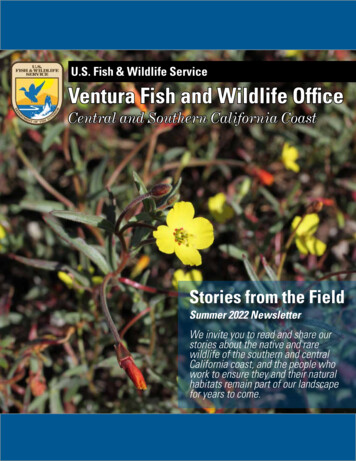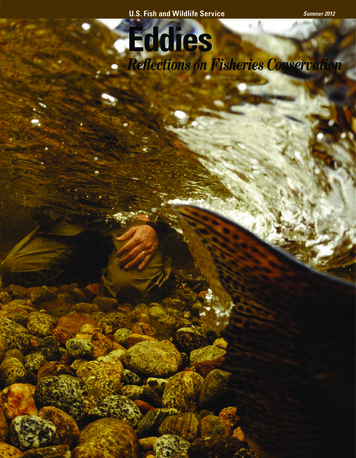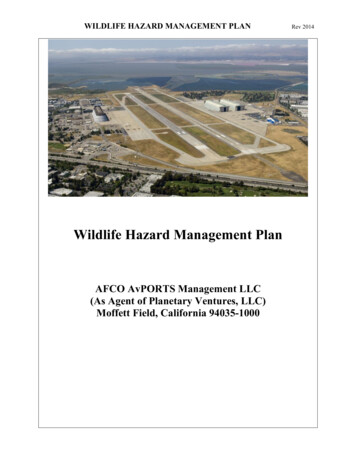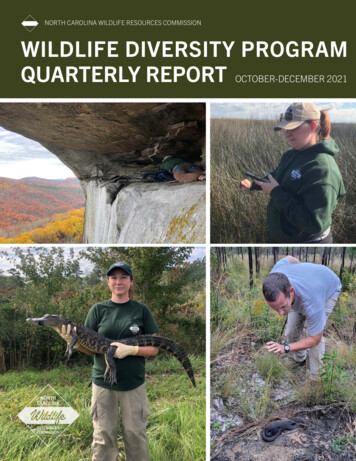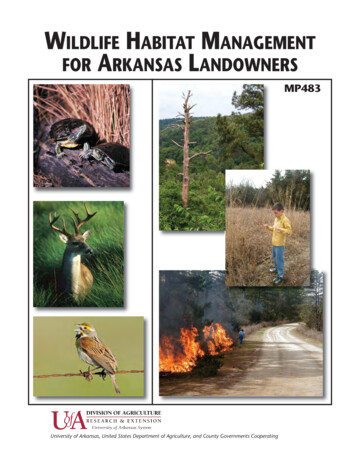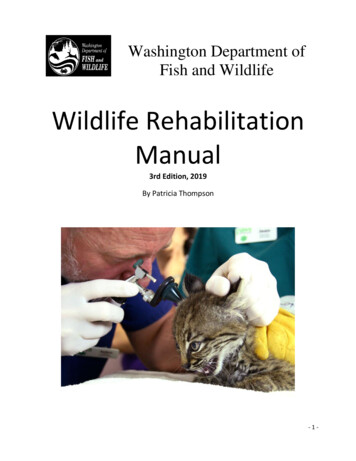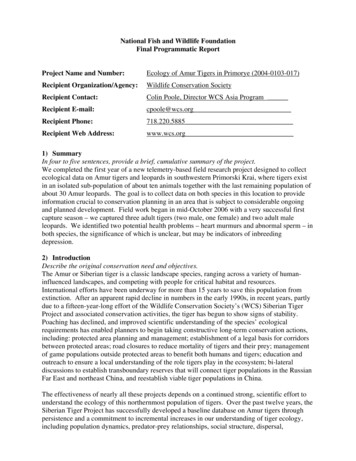
Transcription
National Fish and Wildlife FoundationFinal Programmatic ReportProject Name and Number:Ecology of Amur Tigers in Primorye (2004-0103-017)Recipient Organization/Agency:Wildlife Conservation SocietyRecipient Contact:Colin Poole, Director WCS Asia ProgramRecipient E-mail:cpoole@wcs.orgRecipient Phone:718.220.5885Recipient Web Address:www.wcs.org1) SummaryIn four to five sentences, provide a brief, cumulative summary of the project.We completed the first year of a new telemetry-based field research project designed to collectecological data on Amur tigers and leopards in southwestern Primorski Krai, where tigers existin an isolated sub-population of about ten animals together with the last remaining population ofabout 30 Amur leopards. The goal is to collect data on both species in this location to provideinformation crucial to conservation planning in an area that is subject to considerable ongoingand planned development. Field work began in mid-October 2006 with a very successful firstcapture season – we captured three adult tigers (two male, one female) and two adult maleleopards. We identified two potential health problems – heart murmurs and abnormal sperm – inboth species, the significance of which is unclear, but may be indicators of inbreedingdepression.2) IntroductionDescribe the original conservation need and objectives.The Amur or Siberian tiger is a classic landscape species, ranging across a variety of humaninfluenced landscapes, and competing with people for critical habitat and resources.International efforts have been underway for more than 15 years to save this population fromextinction. After an apparent rapid decline in numbers in the early 1990s, in recent years, partlydue to a fifteen-year-long effort of the Wildlife Conservation Society’s (WCS) Siberian TigerProject and associated conservation activities, the tiger has begun to show signs of stability.Poaching has declined, and improved scientific understanding of the species’ ecologicalrequirements has enabled planners to begin taking constructive long-term conservation actions,including: protected area planning and management; establishment of a legal basis for corridorsbetween protected areas; road closures to reduce mortality of tigers and their prey; managementof game populations outside protected areas to benefit both humans and tigers; education andoutreach to ensure a local understanding of the role tigers play in the ecosystem; bi-lateraldiscussions to establish transboundary reserves that will connect tiger populations in the RussianFar East and northeast China, and reestablish viable tiger populations in China.The effectiveness of nearly all these projects depends on a continued strong, scientific effort tounderstand the ecology of this northernmost population of tigers. Over the past twelve years, theSiberian Tiger Project has successfully developed a baseline database on Amur tigers throughpersistence and a commitment to incremental increases in our understanding of tiger ecology,including population dynamics, predator-prey relationships, social structure, dispersal,
reproduction, and survivorship. This database is the backbone of our conservation efforts, and iswhat distinguishes our efforts from all other conservation organizations working in the region:we recommend conservation actions based on our understanding of tiger ecology, and therequirements for population persistence. Our research efforts provide a platform to conductconservation in a responsible and effective manner, and provide us the credibility to addressbureaucrats and politicians as scientists with a real understanding of tiger ecology andconservation needs.The goal at the start of the Siberian Tiger Project was to collect baseline ecological data and, tothis end, we chose a strictly protected area to conduct our research roughly in the center of theAmur tiger’s geographic range: the Sikhote-Alin Zapovednik. However, now that we havedeveloped a considerable database onbaseline tiger ecology with which tomake comparisons, it is time to beginresearch on tiger populations in otherareas to determine the effects ofvarious perturbations on tigers. It isclear that in many unprotected areasthroughout the Amur tiger’s range,prey populations have been severelydepleted, yet monitoring has notdetected declines in tiger populations.Learning how tigers survive in theseareas, and their reproductive andmortality rates, may provide importantkeys to tiger conservation.Southwestern Primorye represents thesouthern edge of the Amur tiger’scurrent geographic range and ofparticular conservation importance inRussia because it represents astronghold for many species at thenorthern edge of their geographicrange, including tigers, leopards,Figure 1. Southwestern Primorye, including the location ofprotected areas and a proposed study area, NezhanskayaAsiatic black bears, and yellow(Neshinskoe) Hunting Lease.throated marten. Although much ofthe area is protected (Figure 1), it isclose to the primary human population centers of Primorski Krai, and subject to high levels ofhuman disturbance and development and, consequently, the focus of considerable conservationattention. Conducting a research project in the area would be beneficial for several reasons:1. This Amur tiger subpopulation is isolated from the main population to the north, but thedegree of isolation is unclear. Snow-tracking surveys conducted in the winter of 20022003 suggest that the population has increased over the past several years more rapidlythan would be expected from reproduction alone (Pikunov et al. 2003), suggesting thattigers are immigrating from the north. Telemetry studies of this population would allowus to determine the degree of isolation and identify movement/dispersal corridors (or lackthereof) between it and the northern population.2
2. The area borders the most important habitat in China, including the recently createdHunchun Tiger-Leopard Protected Area in Jilin (Figure 1) and proposed protected area inSuiyang District in Heilongjiang. Telemetry studies would allow us to determine thedegree of movement between Russia and China and the fate of tigers once they reachChina, as well as to identify movement corridors in the transboundary area.3. The area is the focus of several proposed or ongoing development programs, including animproved and expanding road network, railway development, expansion of the electricitygrid, mineral/coal extraction, and potential development associated with the Tumen RiverArea Development Program. Data are badly needed on which to base recommendationsto minimize the impact of these development projects. Additionally, our presence in thearea gives us credibility with bureaucrats and politicians as scientists who understandtiger ecology and conservation needs.4. Our focal study area, the Neshinskoe Hunting Lease, is unprotected and subject to highlevels of human activity, especially over-harvest of prey, which is likely similar to otherunprotected areas and vastly different from the Sikhote-Alin Zapovednik. Comparingdata between these two sites will improve our understanding of the effects of humanactivities on tiger populations.5. This area also contains the last existing population of Amur leopards, of which about 30individuals remain in the wild. Current plans for leopard recovery include ecologicalresearch, construction of a captive breeding center, establishment of a second population,and possible supplementation of the existing population by releasing captive animals intothe wild. A clear understanding of tiger ecology and the relationship between the twospecies is critical to the successful recovery of Amur leopards. Competition with tigersmay be an important factor to conservation planning in the region. According to Valov(1989), historical evidence clearly suggests that leopards were common in LazovskiiZapovednik at a time when the tiger was absent. As tiger numbers increased during the1960s and early 1970s, leopard tracks were less often encountered, and then disappearedentirely. A documented kill of a leopard by a tiger was reported in March 2001 in theBorisovkoe Hunting Lease and Mr. V.N. Dyukov, an inspector with Inspection Tiger, hastwice found leopards killed by tigers. Additionally, evidence indicates spatial separationbetween leopards and tigers, suggesting that leopards may avoid areas inhabited by tigers(Figure 2, Miquelle and Murzine 2001). Competition between leopards and tigers hasbeen reported elsewhere (Seidensticker 1976, McDougal 1988) and, at the northern fringeof its range, leopards may be at a significant disadvantage in competing with tigers. Adetailed understanding of the ecology of both species is essential to conserving them, andwill help in the evaluation of conflicts between tiger and leopard conservation.3
Figure 2. Track density for: (a) leopards; and, (b) tigers, based on a kernel estimator of track density;and, (c) areas of overlap in high density. Note that areas of high track density for both species rarelycoincide. Neshinskoe Hunting Lease is shown in yellow.6. Although historically Southwest Primorye was roughly at the center on the north-southgradient of the Amur tiger’s geographic range, it now represents the southwestern edge oftheir range, and differs significantly from the Sikhote-Alin Zapovednik. The climate iswarmer and snow-cover considerably lower than on the Sikhote-Alin Zapovednik. Reddeer, which make up more than 50 percent of tiger prey in the north, are absent inSouthwest Primorye, where sika deer and wild boar are the dominant ungulates.After considerable delay, the Ministry of Natural Resources, Russian Federation, finally issuedpermits to capture four leopards and four tigers in Southwest Primorye in October 2006. Theproject started with a bang – we captured three adult tigers and two adult leopards in one month,marking our most successful capture season in 15 years of work in Russia.Objectives: During our first year of work, we intended to:1. Capture and collar five tigers and five leopards (three adult females and two adultmales of each species).2. Collect blood samples for disease and genetic analyses.3. Monitor captured tigers to collect data on:a. annual and seasonal home range size, daily and seasonal movements, landtenure system, and social structure;b. reproduction (timing of breeding and birth, litter sizes, interval betweenlitters);c. rates and sources of mortality;d. dispersal and long-range movements, particularly in the Russia/China borderarea;4
e. food habits and prey biomass requirements to estimate tiger pressure on preypopulations;f. habitat use;g. relationship between tigers and leopards, including interactions andavoidance, and overlap in space, habitat, and diet.3) MethodsDescribe all activities and methods. Give a yearly breakdown if this is a multi-year grant.PersonnelResearch is directed by Dr. John Goodrich, Dr. Alexey Kostirya, and Dr. Dale Miquelle, with Dr.Goodrich on site three months per year and Dr. Kostirya on site full time. Alexey Kostirya of theInstitute of Biology and Soils (Far Eastern Branch of the Russian Academy of Sciences) workedfor the Siberian Tiger Project (STP) from 1992 to 2001, and for WCS to date. He is the onsiteRussian supervisor of a team of three field technicians. Kostirya has been conducting cameratrap surveys in Southwest Primorye since 2002, so he is familiar with the area. Two STP fieldtechnicians, Alexander Rybin and Vasily Shukin, work full time on this project. Othertechnicians are hired part time as needed. Rybin has been with the STP full time since 1998. Hereceived formal training in capture and handling techniques in both Russia and the United States,and is an undergraduate student in ecology.Study AreaWe chose Neshinskoe Hunting Lease as the focal area for this study for several reasons. Thearea has good densities of both tigers and leopards, as determined from camera-trapping andsnow-tracking surveys in the winters from 2002 to 2007 (i.e. Pikunov et al. 2003). We havealready identified several areas where both species use well-defined travel routes, resulting inrelatively high capture success rates. We are already familiar with the area because we haveconducted leopard surveys. Also, we have a good working relationship with the Pacific OceanFleet Naval Hunting Society because the Neshinskoe lease is one of the primary hunting leasessupported by the WCS project, “Managing hunting leases for effective wildlife/tigerconservation.”MethodsCapture activities began in October 2006, using techniques developed in the Siberian TigerProject (Goodrich et al. 2001). In short, tigers and leopards were captured in foot snares andanesthetized with Zolatil. Adult tigers were fitted with GPS collars with a battery life of greaterthan two years and programmed to collect one to four locations per day; or VHF collars. Collarsare programmed to download data on demand, allowing us to collect location data as necessaryand when animals are in accessible areas, which should greatly reduce flight time and associatedexpenses. Leopards were fitted with conventional VHF transmitters.Although animals with GPS collars must be found via VHF at some point in order to downloadthe data saved in their collars, GPS collars provide a number of advantages over conventionalVHF transmitters. Locations can be collected daily and automatically, regardless of our abilityto regularly find an animal. More frequent and accurate locations improve our ability to locateprey items, especially small prey that tigers finish quickly, and will allow us to develop moreaccurate estimates of tiger pressure on ungulate populations. Perhaps most importantly, GPScollars allow us to monitor remote or otherwise inaccessible areas and animals – areas such asthe border between Russia and China, and animals such as adult males and dispersing young thatmove over large areas and are difficult to monitor via conventional telemetry. With GPS collars,5
we can collect detailed information on travel routes of dispersing animals, allowing us to identifyimportant travel and dispersal corridors.Animals with either collar type are monitored from the ground on foot and in vehicles. Becausedata from GPS collars are downloadable on demand, we can retrieve data opportunistically fromthe ground when an animal is within signal range. Collecting locations will provide data onannual and seasonal home range size, daily and seasonal movements, land tenure system, socialstructure, dispersal, habitat use, and to some extent, the relationship between tigers and leopards.4) Resultsa) Outputsi) Using the logic framework model presented with your application (Fig. 1), enter inactual values of short-term outputs. Enter in any additional indicators not includedin the full proposal used in the analysis. If your application did not include the logicframework, describe project outputs, any realized post-project outcomes and quantifythe results using indicators and baselines.ii) Attach any supplemental graphs, maps, photos and other types of analytical outputfor the project evaluation.iii) Identify and briefly explain discrepancies between what actually happened comparedto what was predicted to happen in the grant proposal using information presentedabove.Logic FrameworkThere was no logic framework in the original proposal. Project outputs relative to initialobjectives are described below, quantified where possible, and discrepancies between intendedand actual results are discussed.Current Project StatusAfter considerable delay, the Ministry of Natural Resources, Russian Federation, issued permitsto capture four leopards and four tigers in Southwest Primorye in October 2006. We capturedAmur tigers and Amur leopards from October 18 through November 17, 2006 in the upperreaches of the Neshina River on the Neshinskoe Hunting Lease, where we established a tentcamp as a base of activities. The capture team consisted of Dr. Kostyria, Dr. Goodrich (WCS),Ivan Seryodkin (Institute of Geography, Far Eastern Branch of Russian Academy of Sciences),Mr. Rybin (WCS), Melody Roelke (National Institutes of Health), and a representative ofInspection Tiger. We set 15 Aldrich snares with transmitters that would emit a signal with aspecific frequency for each snare when an animal was captured. We monitored snares 24 hours aday, and visually checked snares at least once every morning. When a signal was received, dayor night, we immediately checked the snare and anesthetized the animal captured.6
Table 1. Notes on animals captured in Southwest Primorski Krai, Russia, October 18,2006 – November 17, 2006.Estimated WeightDateID No. Sex age (yrs) (kgs)Notes10/26/2006 Pt82M12-16180Tiger; fit with GPS collar; poachedon November 16, 200610/29/2006 Pp01M12-1445Leopard11/02/2006 Pp02M6-757Leopard11/08/2006 Pt83F8-10127Tiger; fit with GPS collar11/10/2006 Pt84M5-6179TigerThe season was one of our most successful in 15 years of work in Primorye - we captured threeadult tigers (Photo 1) and two adult leopards in one month (Table 1), making excellent progresstoward meeting our first project objective (capture and collar five tigers and five leopards). Allanimals were removed from snares within three hours of capture. All animals were in good toexcellent physical condition. While we did not capture any female leopards, tracks of a femaleleopard with at least one cub were noted in the area. Unfortunately, one tiger (Pt82) waspoached just a few weeks after capture (see appended necropsy report). We trapped again inspring 2007 and unintentionally recaptured Pp01. Capture efforts in the spring were hindered byunusually deep snow, which prevented access to the back country; hence, we did not meet ourobjective of capturing five tigers and five leopards.We made excellent progress toward our second objective: Collect blood samples for disease andgenetic analyses, and conduct full biomedical analyses. Veterinarians Melody Roelke(Laboratory of Genomic Diversity, National Institutes of Health, USA) and John Lewis (WildlifeVets International, UK) collected biological materials including blood, tissue, sperm (from Pt84and Pp01), and hair, and conducted medical evaluations of all animals captured, and twopoached animals (Pt82 and an unmarked young female leopard found in spring 2007). Extensiveanalyses of the biological materials are necessary before any conclusive results can bedetermined, but preliminary analyses suggest the following:1. The first leopard captured (Pp01) was dehydrated (8-10 percent) and was providedintravenous fluids (Photo 2). The reason for dehydration was unclear.7
Photo 1. John Goodrich (WCS) fits a radio-collar on a large (179 kg) adult male tiger while Melody Roelke(National Institutes of Health) collects sperm. All animals captured were in good physical condition, as thisphoto suggests.2. Significant heart murmurs were noted for Pt83 and Pp01 (and two other leopards capturedafter the report period). These murmurs did not appear to be of immediate danger to thesurvival of these animals and both appeared healthy. However, the presence of heartmurmurs in two otherwise healthy individuals raises concerns about the health of theoverall populations of tigers and leopards in Southwest Primorye. Heart conditions canhave a genetic basis, and may be an indication of inbreeding depression. However, todetermine the significance of these findings, more animals will need to be assessed.Currently, we are using field ECG and ultrasound to collect further data on heartconditions (Photo 3).3. Sperm was collected from one leopard and one tiger (Photo 2). Preliminary resultsindicate that both had greater than 40 percent abnormal sperm forms (i.e. deformedheads, coiled tails, severely distorted mid-sections). The quick recovery rate of the othertwo males prohibited semen collection and evaluation.4. Clinical laboratory findings conducted in the field demonstrated that all cats had good redblood cell counts (none were anemic), all were negative for feline leukemia virus andfeline immunodeficiency virus, and all were negative for heartworms. Serum will betested to look at the overall health of each individual (serum chemistry panels) and willbe screened for exposure to disease agents known to be pathogenic to non-domesticfelids.8
A team led by Dr. Kosterya monitored (and continues to monitor) the four remaining animals(Pt83, Pt84, Pp01, Pp02) to collect data toward our third objective, which is to monitor capturedanimals to collect data on:1. Annual and seasonal home range size(Figure 3), daily and seasonal movements,land tenure system, and social structure.2. Reproduction (timing of breeding andbirth, litter sizes, interval between litters).3. Rates and sources of mortality.4. Dispersal and long range movements,particularly in the Russia/China borderarea.5. Food habits and prey biomassrequirements to estimate tiger pressure onprey populations.6. Habitat use.7. Relationship between tigers and leopards,including interactions and avoidance, andoverlap in space, habitat, and diet.Photo 2. Melody Roelke of the National Institutesof Health examines sperm of a wild Amur leopardwhile Ivan Seryodkin of the Russian Academy ofSciences administers intravenous fluids because theleopard was slightly dehydrated.Home range sizes were estimated for one tigerand one leopard (Table 2; Figure 3) and somecomponents of habitat use were also examined(Table 2). Very few locations were collectedon Pp02 due to a collar problem (resolvedwhen he was recaptured after the report period), and we have not received a signal from Pt83’scollar since a week after her capture. We suspect the latter is due to collar failure (common withGPS collars), but it is possible that she was poached and her collar destroyed.Table 2.IDTigersPt82Pt83Pt84LeopardsPp01Pp02Habitat features (means)elevationslopeaspect(m)(degrees) (degrees) NotesNo.locationsHomerange 7na31318300Poached.Collar failure?Collar problem, butreplaced in October2007.9
The critically low number of tigers (about ten individuals) and leopards (about 30 individuals)remaining in the extreme southwest portion of Russia makes them particularly vulnerable to theinsidious effects of chronic inbreeding and to stochastic extinction events which can beprecipitated by infectious disease. The only way to access the clinical, reproductive, and genetichealth of the population, and to identify specific disease threats, is by hands-on evaluations. Ourpreliminary results suggest that there may be complications associated with small population sizeand inbreeding depression of both the leopard and tiger populations in Southwest Primorye.Both are probably isolated populations with little or no opportunity for exchange of geneticmaterials, and we would therefore expect that, sooner or later, burdens associated withinbreeding depression will arrive in these populations, if they are not already present. However,to understand the current situation, it is critical to continue to capture individuals to monitorpopulation health and status. Without active monitoring and a commitment to assessing thehealth of a significant percentage of the population, it will be extremely difficult to make usefulrecommendations to conserve this population.Photo 3. Veterinarian MelodyRoelke uses ultrasound to examine aleopard’s heart in the field.Figure 3. Map of home ranges of tiger Pt84 and leopard Pp01.10
b) Post-Project Outcomesi) If your application did not include a logic framework, please identify any medium- tolong-term results that may occur after the project ends.Expected medium- to long-term results include:1. An understanding of tiger movements between Russia and China, which will help toprotect movement corridors into China from Russia. This will ensure a mechanism forrepopulation of Northeast China with Amur tigers should conditions improve there.2. An understanding of movement patterns between the subpopulation of Amur tigers inSouthwest Primorye and the main population to the north. This will provide informationneeded to create (if necessary) and protect habitat corridors between the twosubpopulations, ensuring sufficient genetic exchange and, hence, the persistence of thesouthern subpopulation.3. A comparison between the population in unprotected areas in Southwest Primorye andthe protected population in Sikhote-Alin Zapovednik will shed light on the effects ofhuman disturbances on tiger populations and, hence, help guide management actions tomitigate these effects.4. A more detailed understanding of tiger prey needs will help to better manage ungulatepopulations as prey for both people and tigers, and provide fuel for education programsdesigned to improve hunter attitudes.5. A better understanding of the ecology of both tigers and leopards in this area will helpconservationists and managers to mitigate the impacts of various development projects onboth carnivore populations.ii) Describe any progress towards achieving these post-project outcomes at this time.As described in section 4a above, we have captured animals and begun monitoring. Theinformation gathered will form the database needed to meet post-project outcomes.iii) Will there be continued monitoring of post-project outcomes beyond the life of thisgrant? Are there adequate resources (staff and funding) for continued evaluation andmonitoring? If not, briefly describe the additional resources needed.Tiger and leopard populations are monitored annually in the winter by snow-tracking andcamera-trapping. A variety of organizations are involved in this monitoring, includingthe Institute of Biology and Soils, the Institute of Geography (both under the Far EasternBranch of the Russian Academy of Sciences), World Wildlife Fund, and WCS. In alllikelihood, this monitoring will continue indefinitely, so long as concern for theseendangered populations continues. Such monitoring will provide a basis for assessing theimpacts of conservation actions based on changes in animal numbers.iv) Describe any revisions in the indicators, methods and data that may be needed forpost-project monitoring.11
While our research is based primarily on capture and telemetry, post-project monitoringwill involve population estimation using camera-trapping and snow-tracking. Thesemonitoring efforts began before our research project and continue to date.5) Discussion & Adaptive Managementa) Lessons Learned and Transferabilityi) Describe the lessons learned about effective and ineffective conservation practicesassociated with this project. Which of these key lessons should be shared with otherconservation organizations?ii) To what extent did the evaluation and monitoring activities for this project informyour organization about effective conservation practices, and what lessons werelearned from an evaluation perspective?iii) Based on these lessons learned, what are your organization’s next steps?As a research effort, this project does not involve direct conservation actions. However,data collected will shed light on the impacts of current and future conservation activities.b) Disseminationi) Describe the extent of information communicated to the general public, key partners,other practitioners, scientific experts. Wherever possible estimate the extent of theoutreach using appropriate quantifiable indicators such as meeting attendance,publication circulation figures etc.As this project is in its infancy, results have not yet been disseminated via scientificoutlets. We have done two press releases in response to capture successes in 2006, whichwere picked up by local and national newspapers and local radio. A short film (aboutfifteen minutes) was produced about the project and the conservation issues it addresses,and was aired in its entirety on local Vladivostok television. Short versions were aired onRussian national news.ii) Attach any publications, brochures, videos, outreach tools, press releases and otherappropriate “products” that resulted from this project.Press releases are appended.c) NFWF Adaptive Managementi) Offer any suggestions for NFWF to help guide improvement of our projectadministration.None.12
6) Referencesi) Attach a list of secondary references used in conducting the project, including theevaluation.The following is a condensed selection of references used in designing this project. An exhaustive listwould include a wide variety of literature on felids, other carnivores, and data analysis and statisticaltechniques.Abramov, V. K. 1962. On the biology of the Amur tiger, Panthera tigris longipilis Fitzinger,1868. Vestn. Ceskoslov. Spolecnsti Zool. 26:189-202. In Russian.Baogang, S., D. G. Miquelle, Y. Xiaochen, E. Zhang, S. Hiyai. G. Goshen, D. G. Pikunov, Y.M. Dunishenko, and I. G. Nikolaev, and L. Daming. 1999. 1999 Survey of Amur Tigersand Far Eastern Leopards in Eastern Heilongjiang Province, China, andRecommendations for their Conservation. A final report to The Wildlife ConservationSociety. 67pp.Bogatov, V. V., D. G. Miquelle, S. M. Krasnepeev, V. A. Rosenberg, and W. T. Merrill. 1997.Biodiversity Assessment and Planning Biodiversity Conservation in the Russian FarEast. 1997.TaxoNewSia 1(1).Bogatov, V. V., D. G. Miquelle, V. A. Rozenberg, B. A. Voronov, S. M. Krasnopeev, and T.Merrill. 2000. A Biodiversity conservation strategy for the Sikhote-Alin. RussianAcademy of Sciences, Far Eastern Branch, USAID Environmental Policy andTechnology Project. Vladivostok, Zov Taigi. 80ppCarroll, C. and D.G. Miquelle. 2006. Spatial viability analysis of Amur tiger Panthera tigrisaltaica in the Russian Far East: the role of protected areas and landscape matrix inpopulation persistence. J. Appl. Ecol. 43:1056-1068Goodrich, J. M., L. L. Kerley, D. G. Miquelle, E. N. Smirnov, I. G. Nikolaev, H. Quigley, M.Hornocker, B. Schleyer, N. N. Reebin, and A. V. Kosteeria. 1999. Preliminary analysiso
4. Our focal study area, the Neshinskoe Hunting Lease, is unprotected and subject to high levels of human activity, especially over-harvest of prey, which is likely similar to other unprotected areas and vastly different from the Sikhote-Alin Zapovednik. Comparing data between these two sites will improve our understanding of the effects of human



